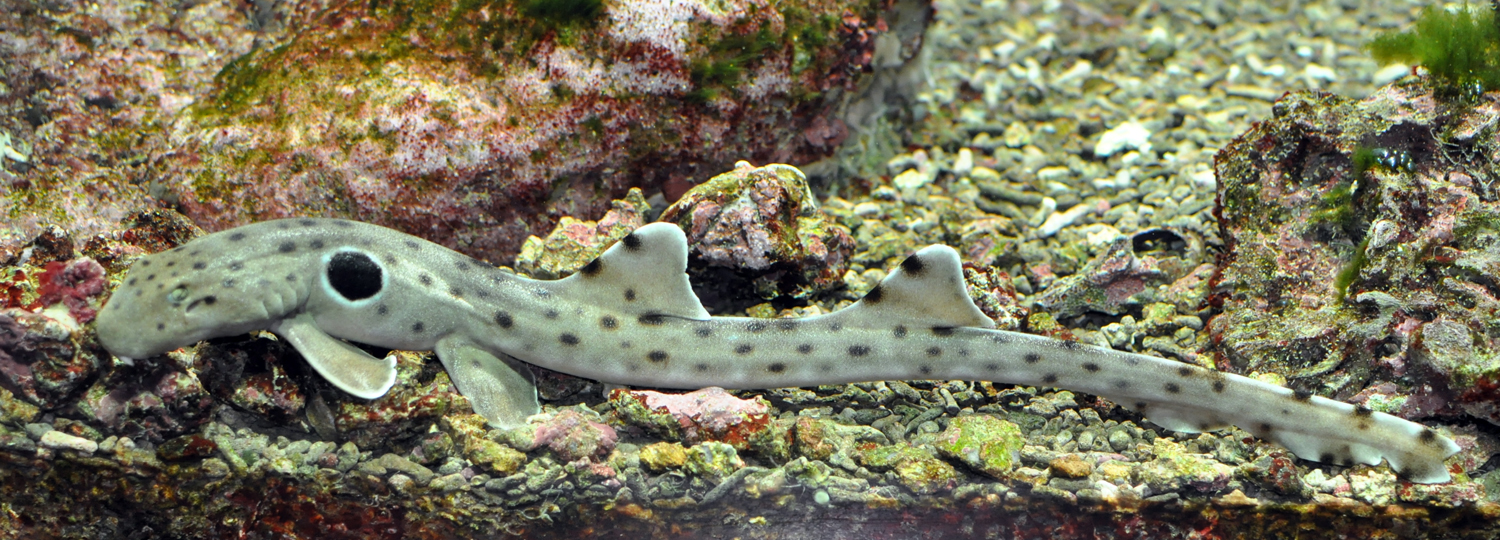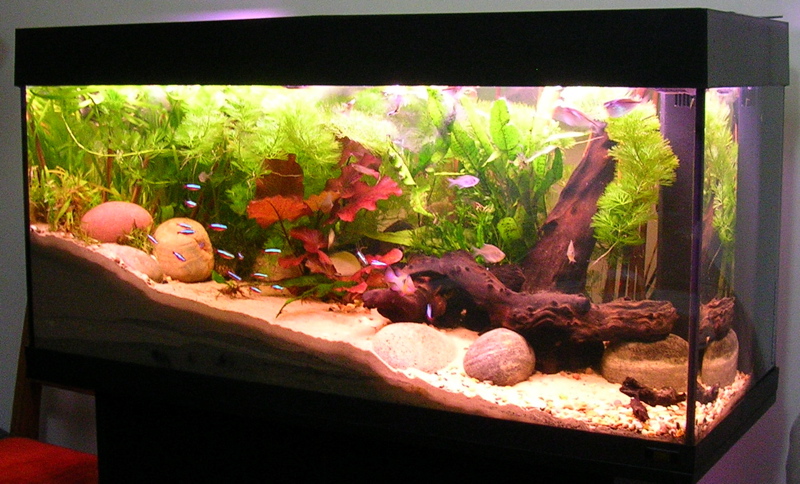|
Epaulette Shark
The epaulette shark (''Hemiscyllium ocellatum'') is a species of longtailed carpet shark, family Hemiscylliidae, found in shallow, tropical waters off Australia and New Guinea (and possibly elsewhere). The common name of this shark comes from the very large, white-margined black spot behind each pectoral fin, which are reminiscent of military epaulettes. A small species usually under long, the epaulette shark has a slender body with a short head and broad, paddle-shaped paired fins. The caudal peduncle (to which the tail fin is attached) comprises over half the shark's length. Adults are light brown above, with scattered darker spots and indistinct saddles. Epaulette sharks have nocturnal habits and frequent shallow water on coral reefs or in tidal pools. This shark has evolved to cope with the severe night time oxygen depletion ( hypoxia) in isolated tidal pools by increasing the blood supply to its brain and selectively shutting down non-essential neural functions. It is ca ... [...More Info...] [...Related Items...] OR: [Wikipedia] [Google] [Baidu] |
Pierre Joseph Bonnaterre
Abbé Pierre Joseph Bonnaterre (1752, Aveyron – 20 September 1804, Saint-Geniez-d'Olt) was a French zoology, zoologist who contributed sections on cetaceans, mammals, birds, reptiles, amphibians, fish, and insects to the ''Tableau encyclopédique et méthodique''. He is also notable as the first scientist to study the feral child Victor of Aveyron. Bonnaterre is credited with identifying about 25 new species of fish, and assembled illustrations of about 400 in his encyclopedia work of book. He was the first scientist to study Victor, the wild child of Aveyron, whose life inspired François Truffaut for his film ''The Wild Child''. Partial bibliography * ''Tableau encyclopédique et méthodique des trois règnes de la nature, dix-huitième partie, insectes.'' Agasse, Paris 1797. * ''Recueil de médecine vétérinaire ou Collection de mémoires d'instructions et de recettes sur les maladies des animaux domestiques.'' * ''Tableau encyclopédique et méthodique des trois règn ... [...More Info...] [...Related Items...] OR: [Wikipedia] [Google] [Baidu] |
Invertebrate
Invertebrates are a paraphyletic group of animals that neither possess nor develop a vertebral column (commonly known as a ''backbone'' or ''spine''), derived from the notochord. This is a grouping including all animals apart from the chordate subphylum Vertebrata. Familiar examples of invertebrates include arthropods, mollusks, annelids, echinoderms and cnidarians. The majority of animal species are invertebrates; one estimate puts the figure at 97%. Many invertebrate taxa have a greater number and variety of species than the entire subphylum of Vertebrata. Invertebrates vary widely in size, from 50 μm (0.002 in) rotifers to the 9–10 m (30–33 ft) colossal squid. Some so-called invertebrates, such as the Tunicata and Cephalochordata, are more closely related to vertebrates than to other invertebrates. This makes the invertebrates paraphyletic, so the term has little meaning in taxonomy. Etymology The word "invertebrate" comes from the Latin word ''vertebra'', whi ... [...More Info...] [...Related Items...] OR: [Wikipedia] [Google] [Baidu] |
Brachaelurus Waddi
The blind shark (''Brachaelurus waddi'') is one of two species of carpet sharks in the family Brachaeluridae, along with the bluegrey carpetshark (''Brachaelurus colcloughi''). Found along the coast of eastern Australia, this nocturnal, bottom-dwelling species is common in rocky areas and seagrass beds from the intertidal zone to a depth of . It often roams in tidal pools where it may be trapped by the receding tide, and can survive for an extended period out of water. Maturing at under long, the blind shark has a stocky, grayish to brownish body with white flecks and darker bands that fade with age. Its head is wide, flattened, and blunt, with small eyes on top and a pair of long barbels underneath. It has large pectoral fins, two nearly equal-sized dorsal fins placed far back on the body, and an anal fin placed close to the caudal fin. The blind shark feeds primarily on small invertebrates and bony fishes. It is aplacental viviparous with females bearing litters of 7&ndash ... [...More Info...] [...Related Items...] OR: [Wikipedia] [Google] [Baidu] |
Queensland
) , nickname = Sunshine State , image_map = Queensland in Australia.svg , map_caption = Location of Queensland in Australia , subdivision_type = Country , subdivision_name = Australia , established_title = Before federation , established_date = Colony of Queensland , established_title2 = Separation from New South Wales , established_date2 = 6 June 1859 , established_title3 = Federation , established_date3 = 1 January 1901 , named_for = Queen Victoria , demonym = , capital = Brisbane , largest_city = capital , coordinates = , admin_center_type = Administration , admin_center = 77 local government areas , leader_title1 = Monarch , leader_name1 = Charles III , leader_title2 = Governor , leader_name2 = Jeannette Young , leader_title3 = Premier , leader_name3 = Annastacia Palaszczuk ( ALP) , legislature = Parliament of Queensland , judiciary = Supreme Court of Queensland , national_representation = Parliament of Australia , national_representation_type ... [...More Info...] [...Related Items...] OR: [Wikipedia] [Google] [Baidu] |
Cooktown
Cooktown is a coastal town and locality in the Shire of Cook, Queensland, Australia. Cooktown is at the mouth of the Endeavour River, on Cape York Peninsula in Far North Queensland where James Cook beached his ship, the Endeavour, for repairs in 1770. Both the town and Mount Cook (431 metres or 1,415 feet) which rises up behind the town were named after James Cook. Cooktown is one of the few large towns in the Cape York Peninsula and was founded on 25 October 1873 as a supply port for the goldfields along the Palmer River.Pike (1979), p. 23.Holthouse, Hector (1967). ''River of Gold: The Wild Days of the Palmer River Gold Rush''. Angus & Robertson. Reprint 2002. HarperCollins ''Publishers'', Australia. ; pp. 27–28. It was called "Cook's Town" until 1 June 1874.Pike (1979), p. 26. In the the locality of Cooktown had a population of 2,631 people. Geography Cooktown is located about north of Brisbane and north of Cairns, by road. Cooktown is about south of Cape York by ro ... [...More Info...] [...Related Items...] OR: [Wikipedia] [Google] [Baidu] |
Type Specimen
In biology, a type is a particular wiktionary:en:specimen, specimen (or in some cases a group of specimens) of an organism to which the scientific name of that organism is formally attached. In other words, a type is an example that serves to anchor or centralizes the defining features of that particular taxon. In older usage (pre-1900 in botany), a type was a taxon rather than a specimen. A taxon is a scientifically named grouping of organisms with other like organisms, a set (mathematics), set that includes some organisms and excludes others, based on a detailed published description (for example a species description) and on the provision of type material, which is usually available to scientists for examination in a major museum research collection, or similar institution. Type specimen According to a precise set of rules laid down in the International Code of Zoological Nomenclature (ICZN) and the International Code of Nomenclature for algae, fungi, and plants (ICN), the ... [...More Info...] [...Related Items...] OR: [Wikipedia] [Google] [Baidu] |
Tableau Encyclopédique Et Méthodique
Tableau (French for 'little table' literally, also used to mean 'picture'; tableaux or, rarely, tableaus) may refer to: Arts * ''Tableau'', a series of four paintings by Piet Mondrian titled ''Tableau I'' through to ''Tableau IV'' * ''Tableau vivant'', a motionless performance evoking a painting or sculpture; or a painting or photograph evoking such a theatrical scene * Scene (drama), in opera, ballet, and some other dramatic forms Games * Tableau (card game), a specific patience card game * Tableau (cards), the layout in patience and fishing card games * Tableau (dominoes), the layout in dominoes Other * Tableau, another term for a table of data, particularly: ** Cryptographic tableau, or tabula recta, used in manual cipher systems ** Division tableau, a table used to do long division * Method of analytic tableaux (also semantic tableau or truth tree), a technique of automated theorem proving in logic * Tableau Software, a company providing tools for data visualization and bus ... [...More Info...] [...Related Items...] OR: [Wikipedia] [Google] [Baidu] |
Fishery
Fishery can mean either the enterprise of raising or harvesting fish and other aquatic life; or more commonly, the site where such enterprise takes place ( a.k.a. fishing ground). Commercial fisheries include wild fisheries and fish farms, both in freshwater waterbodies (about 10% of all catch) and the oceans (about 90%). About 500 million people worldwide are economically dependent on fisheries. 171 million tonnes of fish were produced in 2016, but overfishing is an increasing problem — causing declines in some populations. Because of their economic and social importance, fisheries are governed by complex fisheries management practices and legal regimes that vary widely across countries. Historically, fisheries were treated with a " first-come, first-served " approach, but recent threats by human overfishing and environmental issues have required increased regulation of fisheries to prevent conflict and increase profitable economic activity on the fishery. Modern jurisdictio ... [...More Info...] [...Related Items...] OR: [Wikipedia] [Google] [Baidu] |
Least Concern
A least-concern species is a species that has been categorized by the International Union for Conservation of Nature (IUCN) as evaluated as not being a focus of species conservation because the specific species is still plentiful in the wild. They do not qualify as threatened, near threatened, or (before 2001) conservation dependent. Species cannot be assigned the "Least Concern" category unless they have had their population status evaluated. That is, adequate information is needed to make a direct, or indirect, assessment of its risk of extinction based on its distribution or population status. Evaluation Since 2001 the category has had the abbreviation "LC", following the IUCN 2001 Categories & Criteria (version 3.1). Before 2001 "least concern" was a subcategory of the "Lower Risk" category and assigned the code "LR/lc" or lc. Around 20% of least concern taxa (3261 of 15636) in the IUCN database still use the code "LR/lc", which indicates they have not been re-evaluate ... [...More Info...] [...Related Items...] OR: [Wikipedia] [Google] [Baidu] |
International Union For Conservation Of Nature
The International Union for Conservation of Nature (IUCN; officially International Union for Conservation of Nature and Natural Resources) is an international organization working in the field of nature conservation and sustainable use of natural resources. It is involved in data gathering and analysis, research, field projects, advocacy, and education. IUCN's mission is to "influence, encourage and assist societies throughout the world to conserve nature and to ensure that any use of natural resources is equitable and ecologically sustainable". Over the past decades, IUCN has widened its focus beyond conservation ecology and now incorporates issues related to sustainable development in its projects. IUCN does not itself aim to mobilize the public in support of nature conservation. It tries to influence the actions of governments, business and other stakeholders by providing information and advice and through building partnerships. The organization is best known to the wider pu ... [...More Info...] [...Related Items...] OR: [Wikipedia] [Google] [Baidu] |
Fishkeeping
Fishkeeping is a popular hobby, practiced by aquarists, concerned with keeping fish in a home aquarium or garden pond. There is also a piscicultural fishkeeping industry, serving as a branch of agriculture. Origins of fishkeeping Fish have been raised as food in pools and ponds for thousands of years. Brightly colored or tame specimens of fish in these pools have sometimes been valued as pets rather than food. Many cultures, ancient and modern, have kept fish for both functional and decorative purposes. Ancient Sumerians kept wild-caught fish in ponds, before preparing them for meals. Depictions of the sacred fish of Oxyrhynchus kept in captivity in rectangular temple pools have been found in ancient Egyptian art. Similarly, Asia has experienced a long history of stocking rice paddies with freshwater fish suitable for eating, including various types of catfish and cyprinid. Selective breeding of carp into today's popular and completely domesticated koi and fancy goldfish b ... [...More Info...] [...Related Items...] OR: [Wikipedia] [Google] [Baidu] |





.jpg)



